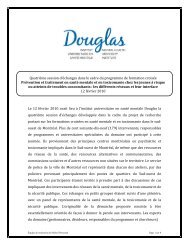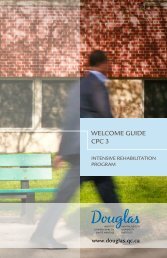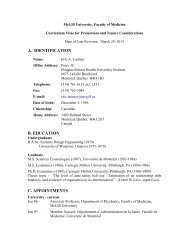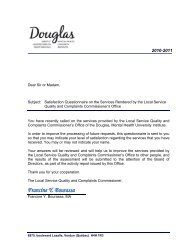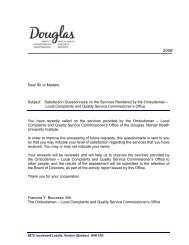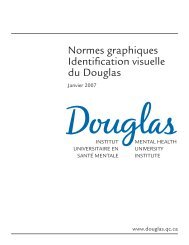Suicide Among Aboriginal People in Canada - Institut universitaire ...
Suicide Among Aboriginal People in Canada - Institut universitaire ...
Suicide Among Aboriginal People in Canada - Institut universitaire ...
You also want an ePaper? Increase the reach of your titles
YUMPU automatically turns print PDFs into web optimized ePapers that Google loves.
Appendix Bwere identified and recommendations generated. This report provides an exam<strong>in</strong>ation of these issues frombasic suicide data to specific factors affect<strong>in</strong>g First Nation and, based on this, presents recommendationsfor action. The recommendations fall <strong>in</strong>to four ma<strong>in</strong> themes: 1) <strong>in</strong>creas<strong>in</strong>g knowledge about what works<strong>in</strong> suicide prevention; 2) develop<strong>in</strong>g more effective and <strong>in</strong>tegrated health care services at national, regional,and local levels; 3) support<strong>in</strong>g community-driven approaches; and 4) creat<strong>in</strong>g strategies for build<strong>in</strong>g youthidentity, resilience, and culture. Available at: http://www.hc-sc.gc.ca/fnih-spni/pubs/suicide/prev_youthjeunes/<strong>in</strong>dex_e.htmlAssessment and Plann<strong>in</strong>g Tool Kit for <strong>Suicide</strong> Prevention <strong>in</strong> First Nations CommunitiesThe Assessment and Plann<strong>in</strong>g Tool Kit for <strong>Suicide</strong> Prevention <strong>in</strong> First Nations Communities was prepared <strong>in</strong>2005 for the First Nations Centre, National <strong>Aborig<strong>in</strong>al</strong> Health Organization. The tool kit was created asa framework for communities to use <strong>in</strong> determ<strong>in</strong><strong>in</strong>g and creat<strong>in</strong>g a suicide prevention plan. The kit, which<strong>in</strong>cludes research and <strong>in</strong>formation on suicide and suicide prevention recommendations, is a guide <strong>in</strong>tendedfor adaptation to the needs of each community. The tool kit is comprised of three phases:• Phase I: Pre-Assessment: Research and Information on <strong>Suicide</strong> and <strong>Suicide</strong> Prevention: <strong>in</strong>cludes<strong>in</strong>formation on understand<strong>in</strong>g suicidal behaviour among youth, <strong>in</strong>clud<strong>in</strong>g what might lead someoneto consider suicide and what the protective factors might be. This section of the tool kit also outl<strong>in</strong>esdifferent approaches to suicide prevention (prevention, <strong>in</strong>tervention, and postvention) and discussesthe importance of <strong>in</strong>volv<strong>in</strong>g all three <strong>in</strong> a prevention <strong>in</strong>itiative. A variety of prevention, <strong>in</strong>tervention,and postvention strategies are suggested. Phase I concludes by recommend<strong>in</strong>g how to develop and<strong>in</strong>corporate assessment, plann<strong>in</strong>g, and consultation <strong>in</strong>to a suicide prevention strategy.• Phase II: Community Assessment: expla<strong>in</strong>s how to gather <strong>in</strong>formation regard<strong>in</strong>g the communitypopulation and access to general programs and services. This section suggests compil<strong>in</strong>g <strong>in</strong>formationon community demographics, <strong>in</strong>frastructure, community health and social programs and services,community views and attitudes about suicide, community suicide itself, community responses tosuicide, community risk factors, other community factors, cultural cont<strong>in</strong>uity factors, and communitystrengths.• Phase III: Develop<strong>in</strong>g a Community Heal<strong>in</strong>g Plan: describes the process of plann<strong>in</strong>g community heal<strong>in</strong>gand suicide prevention through the use of local <strong>in</strong>itiatives, community members, and communityappropriatestrategies. Recommended steps <strong>in</strong>clude: analyz<strong>in</strong>g the community assessment done <strong>in</strong> PhaseII; identify<strong>in</strong>g exist<strong>in</strong>g community programs that may act <strong>in</strong> the capacity of primary prevention resources;identify<strong>in</strong>g exist<strong>in</strong>g programs that may act <strong>in</strong> the capacity of <strong>in</strong>tervention programs or secondaryprevention; identify<strong>in</strong>g exist<strong>in</strong>g programs that may act <strong>in</strong> the capacity of postvention programs; andidentify<strong>in</strong>g specific community strengths. The tool kit then provides numerous questions to help createa framework that may be used to help the community with its suicide prevention plann<strong>in</strong>g process. Thetool kit concludes by emphasiz<strong>in</strong>g the importance of evaluation and by provid<strong>in</strong>g <strong>in</strong>formation that willguide the community <strong>in</strong> develop<strong>in</strong>g an appropriate evaluation for their suicide prevention program.The appendices <strong>in</strong>clude common warn<strong>in</strong>g signs of suicide and key resources for the community to drawupon.Available at: http://www.naho.ca/firstnations/english/documents/NAHO_<strong>Suicide</strong>_Eng.pdf126




